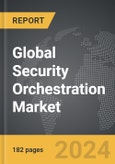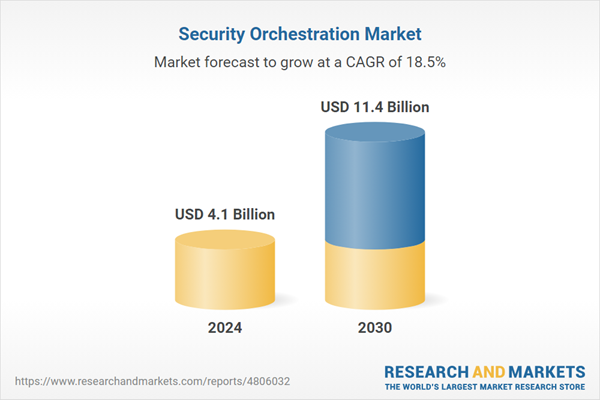The global market for Security Orchestration was valued at US$4.1 Billion in 2024 and is projected to reach US$11.4 Billion by 2030, growing at a CAGR of 18.5% from 2024 to 2030. This comprehensive report provides an in-depth analysis of market trends, drivers, and forecasts, helping you make informed business decisions. The report includes the most recent global tariff developments and how they impact the Security Orchestration market.
Segments: Component (Solutions, Services); Application (Network Forensics, Compliance Management, Ticketing Solutions, Threat Intelligence, Other Applications).
Geographic Regions/Countries: World; United States; Canada; Japan; China; Europe (France; Germany; Italy; United Kingdom; and Rest of Europe); Asia-Pacific; Rest of World.
The analysts continuously track trade developments worldwide, drawing insights from leading global economists and over 200 industry and policy institutions, including think tanks, trade organizations, and national economic advisory bodies. This intelligence is integrated into forecasting models to provide timely, data-driven analysis of emerging risks and opportunities.
Global Security Orchestration Market - Key Trends and Drivers Summarized
Why Is Security Orchestration Becoming Essential for Cyber Defense?
Security orchestration is rapidly becoming a cornerstone of modern cybersecurity strategies, enabling organizations to automate, streamline, and manage security processes across diverse environments. As the complexity and volume of cyber threats continue to rise, enterprises are finding it increasingly challenging to detect, analyze, and respond to incidents manually. Security orchestration platforms provide centralized management and automation of threat detection, incident response, and remediation workflows, reducing response times and minimizing human error. These platforms integrate with a wide range of security tools, such as SIEM (Security Information and Event Management), firewalls, endpoint protection, and threat intelligence feeds, to provide a unified and automated approach to cybersecurity operations. The increasing shortage of skilled cybersecurity professionals is further driving the adoption of security orchestration solutions, as they help organizations maximize the efficiency and effectiveness of their existing security teams.How Are Technological Advances Shaping the Future of Security Orchestration?
Technological advancements are playing a crucial role in the evolution of security orchestration platforms, making them more intelligent, adaptive, and user-friendly. The integration of artificial intelligence (AI) and machine learning (ML) is enhancing the ability of these platforms to detect complex threats, predict potential attack patterns, and automate incident response with minimal human intervention. Low-code and no-code orchestration platforms are emerging, allowing security teams to design and automate workflows without requiring deep coding knowledge, thereby broadening accessibility and speeding up deployment. The development of cloud-native and hybrid orchestration solutions is providing greater flexibility and scalability, catering to the needs of organizations operating in multi-cloud and hybrid environments. Furthermore, the focus on open and interoperable orchestration architectures is enabling seamless integration with a diverse set of security tools and technologies, enhancing overall threat detection and response capabilities.Which Market Segments Are Driving the Adoption of Security Orchestration?
The security orchestration market is segmented by component, deployment mode, organization size, end-use industry, and region. Components include solutions and services, with orchestration platforms and automated incident response solutions being widely adopted. Deployment modes are categorized into on-premises, cloud-based, and hybrid, with cloud-based orchestration gaining momentum due to its scalability and ease of integration. Large enterprises are the primary adopters of security orchestration solutions due to their complex IT environments and high exposure to cyber threats. However, small and medium-sized enterprises (SMEs) are increasingly recognizing the benefits of automation in cybersecurity, driving the demand for affordable and easy-to-deploy orchestration solutions. Key end-use industries include financial services, healthcare, government, retail, and IT and telecom, where regulatory compliance, data privacy, and rapid incident response are critical. Geographically, North America leads the market due to advanced cybersecurity infrastructure and high awareness of automated security solutions, while Asia-Pacific is emerging as a high-growth region driven by increasing cyber threats and digital transformation initiatives.What Are the Key Drivers of Growth in the Security Orchestration Market?
The growth in the security orchestration market is driven by several factors, including the increasing complexity of cyber threats, the shortage of skilled cybersecurity professionals, and the rising need for automated threat detection and response. The integration of AI, machine learning, and low-code platforms in security orchestration is enhancing the effectiveness and accessibility of these solutions, making them more attractive to organizations of all sizes. The shift towards cloud-based orchestration and the emphasis on open and interoperable architectures are expanding the market, providing greater flexibility and scalability for multi-cloud and hybrid environments. The growing demand for centralized security management, real-time threat intelligence, and automated incident response is driving the adoption of security orchestration in sectors such as finance, healthcare, and government. Additionally, the focus on reducing mean time to detect (MTTD) and mean time to respond (MTTR) to cyber incidents is further supporting market growth.Report Scope
The report analyzes the Security Orchestration market, presented in terms of units. The analysis covers the key segments and geographic regions outlined below.Segments: Component (Solutions, Services); Application (Network Forensics, Compliance Management, Ticketing Solutions, Threat Intelligence, Other Applications).
Geographic Regions/Countries: World; United States; Canada; Japan; China; Europe (France; Germany; Italy; United Kingdom; and Rest of Europe); Asia-Pacific; Rest of World.
Key Insights:
- Market Growth: Understand the significant growth trajectory of the Solutions segment, which is expected to reach US$8.2 Billion by 2030 with a CAGR of a 18.1%. The Services segment is also set to grow at 19.6% CAGR over the analysis period.
- Regional Analysis: Gain insights into the U.S. market, valued at $1.1 Billion in 2024, and China, forecasted to grow at an impressive 17.4% CAGR to reach $1.7 Billion by 2030. Discover growth trends in other key regions, including Japan, Canada, Germany, and the Asia-Pacific.
Why You Should Buy This Report:
- Detailed Market Analysis: Access a thorough analysis of the Global Security Orchestration Market, covering all major geographic regions and market segments.
- Competitive Insights: Get an overview of the competitive landscape, including the market presence of major players across different geographies.
- Future Trends and Drivers: Understand the key trends and drivers shaping the future of the Global Security Orchestration Market.
- Actionable Insights: Benefit from actionable insights that can help you identify new revenue opportunities and make strategic business decisions.
Key Questions Answered:
- How is the Global Security Orchestration Market expected to evolve by 2030?
- What are the main drivers and restraints affecting the market?
- Which market segments will grow the most over the forecast period?
- How will market shares for different regions and segments change by 2030?
- Who are the leading players in the market, and what are their prospects?
Report Features:
- Comprehensive Market Data: Independent analysis of annual sales and market forecasts in US$ Million from 2024 to 2030.
- In-Depth Regional Analysis: Detailed insights into key markets, including the U.S., China, Japan, Canada, Europe, Asia-Pacific, Latin America, Middle East, and Africa.
- Company Profiles: Coverage of players such as Blumira, Brace168 Pty Ltd., Chelys, Cisco Systems, Inc., CloudCover and more.
- Complimentary Updates: Receive free report updates for one year to keep you informed of the latest market developments.
Some of the 17 companies featured in this Security Orchestration market report include:
- Blumira
- Brace168 Pty Ltd.
- Chelys
- Cisco Systems, Inc.
- CloudCover
- Delta Risk LLC
- Demisto Inc.
- FireEye, Inc.
- IBM Corporation
- Logrhythm, Inc.
Tariff Impact Analysis: Key Insights for 2025
Global tariff negotiations across 180+ countries are reshaping supply chains, costs, and competitiveness. This report reflects the latest developments as of April 2025 and incorporates forward-looking insights into the market outlook.The analysts continuously track trade developments worldwide, drawing insights from leading global economists and over 200 industry and policy institutions, including think tanks, trade organizations, and national economic advisory bodies. This intelligence is integrated into forecasting models to provide timely, data-driven analysis of emerging risks and opportunities.
What’s Included in This Edition:
- Tariff-adjusted market forecasts by region and segment
- Analysis of cost and supply chain implications by sourcing and trade exposure
- Strategic insights into geographic shifts
Buyers receive a free July 2025 update with:
- Finalized tariff impacts and new trade agreement effects
- Updated projections reflecting global sourcing and cost shifts
- Expanded country-specific coverage across the industry
Table of Contents
I. METHODOLOGYII. EXECUTIVE SUMMARY2. FOCUS ON SELECT PLAYERSIII. MARKET ANALYSISIV. COMPETITION
1. MARKET OVERVIEW
3. MARKET TRENDS & DRIVERS
4. GLOBAL MARKET PERSPECTIVE
UNITED STATES
CANADA
JAPAN
CHINA
EUROPE
FRANCE
GERMANY
ITALY
UNITED KINGDOM
REST OF EUROPE
ASIA-PACIFIC
REST OF WORLD
Companies Mentioned (Partial List)
A selection of companies mentioned in this report includes, but is not limited to:
- Blumira
- Brace168 Pty Ltd.
- Chelys
- Cisco Systems, Inc.
- CloudCover
- Delta Risk LLC
- Demisto Inc.
- FireEye, Inc.
- IBM Corporation
- Logrhythm, Inc.
Table Information
| Report Attribute | Details |
|---|---|
| No. of Pages | 182 |
| Published | April 2025 |
| Forecast Period | 2024 - 2030 |
| Estimated Market Value ( USD | $ 4.1 Billion |
| Forecasted Market Value ( USD | $ 11.4 Billion |
| Compound Annual Growth Rate | 18.5% |
| Regions Covered | Global |









